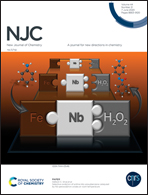A turn-on luminescent probe for Fe3+ and ascorbic acid with logic gate operation based on a zinc(ii)-based metal–organic framework†
Abstract
A 2D zinc(II)-based metal–organic framework (Zn-MOF) formulated as [Zn(bimpy)(1,4-ndc)]·H2O (1, bimpy = 3,5-bis(1-imidazolyl)pyridine and 1,4-ndc = 1,4-naphthalenedicarboxylic acid) was synthesized by solvothermal reaction. Complex 1 exhibits high water and pH-independent stability. It can detect Fe3+ and ascorbic acid (AA) as a “turn-off” fluorescence probe and a “turn-on” fluorescence probe in aqueous solution with high sensitivity and selectivity, respectively. The detection limits of 1 for Fe3+ and AA are about 8.82 × 10−7 M and 6.12 × 10−7 M, respectively. The fluorescence intensity of the Fe3+@1 system can be obviously recovered after adding AA due to the reduction of Fe3+, which exhibits a fluorescence “turn-on” signal (turn-off–on) for Fe3+@1 toward AA with a low detection limit (3.53 × 10−7 M). Complex 1 still exhibits good detection of Fe3+ and AA after washing and using for five cycles. Additionally, two different multi-input molecular logic gates are established. One is used to distinguish the effect of Fe3+ and Fe2+ on the fluorescence of complex 1, and the other is to further explain the regulation of Fe3+ and AA on the fluorescence of complex 1. This work shows that complex 1 is the first MOF-based “turn-on” fluorescent probe for both Fe3+ and AA in aqueous solution.



 Please wait while we load your content...
Please wait while we load your content...